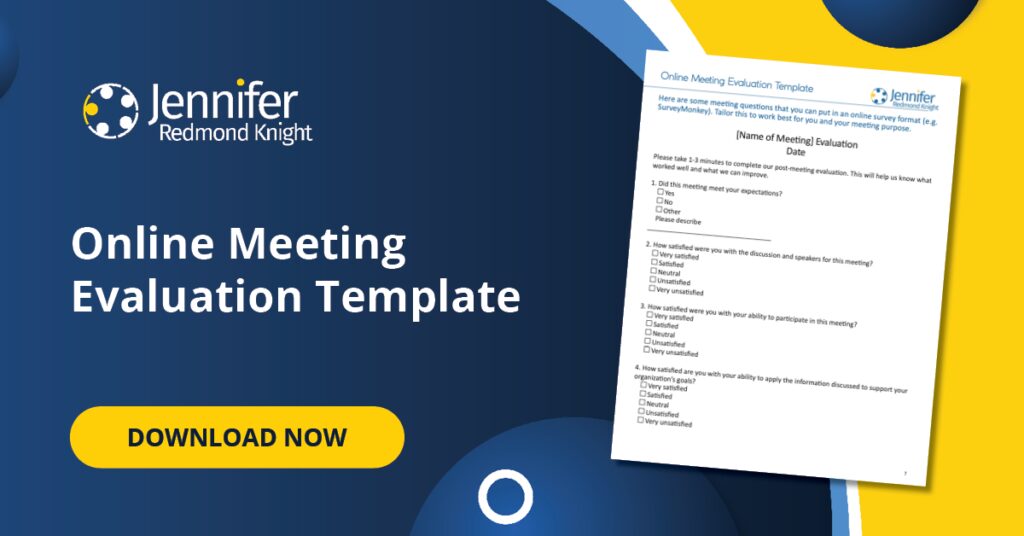As we plan and prepare our coalition meetings, we have lots of decisions to make about the type(s) of meetings we host. We once again have opportunities to meet in person, sometimes we host hybrid meetings and we continue to have most of our meetings in a virtual platform. Prior to 2020, virtual meetings were often the back-up plan. Since we cannot all meet in person, I guess we should meet virtually. Now we have changed our approach. Our default meeting approach is virtual and there has to be a compelling reason for us to meet in person. Since our work continues to focus on online meetings, we have to keep practicing and learning what works and what does not work for our specific meeting needs and audiences. Join me in today’s post where I highlight my top 10 tips for facilitating online meetings.
Be clear about the meeting purpose.
Whenever you have a meeting, whether it is a standing meeting or a one-time meeting, consider your intention and purpose for the meeting. This will influence the rest of the details needed to plan a meeting and whether a meeting is needed. Practice writing the purpose in one sentence. Say it outloud. Check in with your staff or other coalition leaders. This is a key to avoiding “online meeting fatigue”.
Garner support from your team.
This is particularly important if you are leading a large group meeting online. You need help in order to effectively host the meeting. When you plan the meeting, consider the roles of each of your team members and how you can each contribute based on your skills and areas of expertise. Don’t try to do it alone!
Set expectations about participation.
Related to the purpose, setting expectations helps everyone know what to expect and how to show up and engage in the meeting. If you are trying to work on a project with a small group, you will have different expectations regarding participation than if you are leading a webinar. Let participants know when it would be a good time to show their video or turn off their video. If you want people to ask questions during a presentation, let them know. Consider connection questions that will support engagement and set the example for participation. One of my favorite resources that I use both in virtual and in-person meetings comes from We and Me connect cards.
Share your screen.
One of the best things about a virtual meeting is the ability to work on something in “real time” and then share it with your team right after the meeting. Although it can sometimes be intimidating, (and you may be concerned about your spelling!) sharing your screen is a powerful way to help all participants focus and work together. When you share your screen (or someone on your team does) you are able to check in with the group to see if you agree, disagree or need to make adjustments. This helps the virtual meeting platform become an efficient way to work together.
Use video to see one another.
You can more effectively facilitate the meeting when you are able to see nonverbal communication. This also helps increase the “energy” in the virtual room. Video is especially important when you are getting to know one another and have a discussion or question and answer session. Continue to consider your purpose and set expectations for participation as it relates to video. Depending upon the purpose of the meeting, you may not always need to use video during the entire meeting. When you provide clear guidance on the times when video is encouraged for participation and when attendees can have “permission” to be off camera, this can help with engagement during the times you want people to show their video.
Mute all lines.
You can ask folks to mute themselves, but there is always one…and it just takes one…:) This is where you need someone on your team (or multiple people) to have the power to mute all lines. I am so accustomed to helping mute lines that if I am not serving this role, I still try to “mute” those people who forget that their microphone is live. This very small detail makes a big difference in the ability for attendees to participate and focus on the meeting without being distracted by unexpected noises or voices.
Call on people directly.
Just this week, I heard the phrase “call them in” when referring to bringing people into the conversation. I really like this approach. When you call on people (or send a direct message in the chat), you are honoring their work and inviting their contribution. Depending upon the meeting, some people may not think that their input is as valuable as others. When you call on them and encourage them to share their perspectives, you are showing that their perspective is important. For those who are less comfortable sharing in a large group, consider sending a direct message in chat first to confirm that they would be comfortable with you inviting them to directly participate.
Use the chat feature (and other technology).
When you use the chat or polling features, you are encouraging participation from your entire group. Not everyone is comfortable with speaking and sharing their perspective (it’s like public speaking!). When you incorporate poll and chat questions, you can garner feedback from more participants and check in with your group related to the discussion. This can help you collect immediate feedback, understand the perspectives of your participants and consider action items. One of my favorite final chat questions in a meeting is “What is one action you plan to take from today’s meeting?”
Keep meetings short.
Let the purpose and the preferences of participants dictate the length of the meeting. Why does every meeting need to be an hour?! When we keep our meetings shorter than an hour, we can focus the conversation on the most important priorities and give ourselves time for breaks within our day that will support our energy. Also, sometimes, you may realize that your team members are not able to fully engage in the conversation or content. Rather than continue to try to keep the meeting going longer, consider scheduling a follow-up meeting after the group has time to reflect on the discussion and have renewed energy.
Follow-up in a timely manner .
When planning a meeting, consider scheduling time on your calendar for right after the meeting (or within the next couple of days) to follow-up. One of our challenges in coalition work is that we move from one meeting to the next without giving ourselves time to reflect and process. The sooner you are able to reflect and follow-up, the better you will be able to maintain momentum and productivity. This also helps with continued engagement in your coalition work
What about you? Which of these 10 tips are you going to practice for your next meeting?
One of the ways to check in with your coalition, workgroups, networks and teams is to conduct meeting evaluations. Click here to access my free “Online Meeting Evaluation Template” that you can tailor for your next meeting.

Photo by Chris Montgomery on Unsplash

